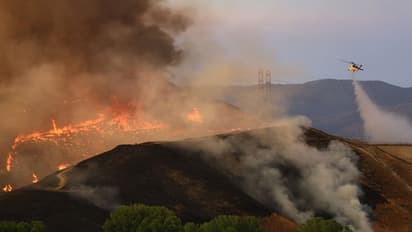California wildfire burn homes, force towns to flee: Report

Synopsis
Weed, Lake Shastina and Edgewood were placed under mandatory evacuation orders, children from a local high school were sent to safety, and a large animal and livestock evacuation shelter was set up.
Thousands of people were on Friday ordered to evacuate their homes in northern California as a wildfire spread rapidly across more than 1,000 acres in extremely hot conditions.
Footage from a local news channel showed several buildings ablaze in the so-called Mill Fire, which the Siskiyou county fire department warned was growing at a "dangerous rate of spread."
Also read: Former Sri Lanka President Gotabaya Rajapaksa, who fled amid unrest, returns home
Weed, Lake Shastina and Edgewood were placed under mandatory evacuation orders, children from a local high school were sent to safety, and a large animal and livestock evacuation shelter was set up.
"Immediate threat to life. This is a lawful order to leave now. The area is lawfully closed to public access," said the evacuation order.
The inferno came as California and parts of Nevada and Arizona broiled under another day of blistering temperatures.
Also read: Liz Truss looks poised to win UK PM race; Here's everything you need to know about her
Temperatures in many areas have risen above 100 degrees Fahrenheit (38 degrees Celsius) due to a persistent bubble of high pressure sitting over the region.
In its daily bulletin, the National Weather Service said, "September is off to a searing start in the West with record breaking temperatures and fire weather expected to expand and settle over that part of the country this Labor Day weekend."
Siskiyou is part of a largely forested and relatively less populous region of northern California that has been hit badly by wildfires in recent years.
Also read: Poland seeks USD 1.3 trillion from Germany for World War II invasion, occupation
In 2014, more than 150 buildings were destroyed in the town of Weed by the Boles fire. According to scientists, global warming, which is being driven chiefly by the unchecked burning of fossil fuels, is making natural weather variations more extreme.
A persistent drought lasting more than two decades has also left much of the American West baked and tinder dry, leaving it vulnerable to hotter, faster and more destructive wildfires.
Check the Breaking News Today and Latest News from across India and around the world. Stay updated with the latest World News and global developments from politics to economy and current affairs. Get in-depth coverage of China News, Europe News, Pakistan News, and South Asia News, along with top headlines from the UK and US. Follow expert analysis, international trends, and breaking updates from around the globe. Download the Asianet News Official App from the Android Play Store and iPhone App Store for accurate and timely news updates anytime, anywhere.